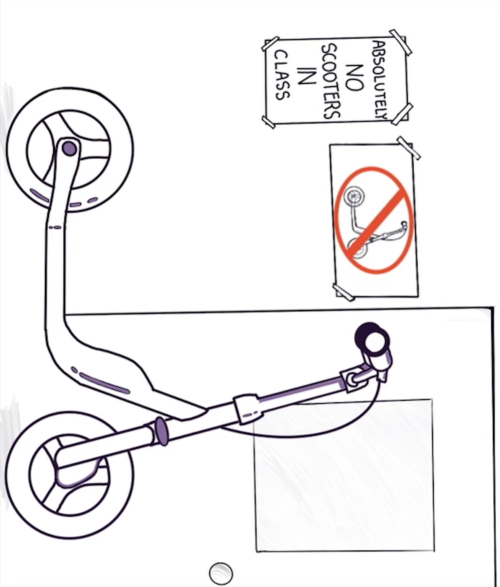Motor scooters remain a constant presence at Harvard, most often used by athletes who want to travel between the athletic facilities—located across the river—and the rest of campus. Despite occasional jokes about errant sidewalk riders and certain classes that seem to attract higher quantities of scooter users, they have become a mainstay in the backs of lecture halls, house hallways, and even on bike racks.
However, a recent spate of scooter thefts has plagued Harvard, leaving scooter owners of all types out to dry. According to the Harvard University Police logs, thirteen electric motor scooters were reported stolen between February 6th and 9th. Of those, five were stolen on February 8th, and six more were stolen on February 9th. The total value of all the reported stolen scooters was $7,569. The most expensive scooter stolen was valued at $1,350. All but one of the scooters were reported as “unattended and unsecured.” While petty thefts are not uncommon in a city like Cambridge, no other motor scooter thefts had occurred since the start of the semester until the sudden four-day spike.
Nine of the thirteen scooters were stolen from the Science Center, and all but one occurred between 3 and 6 PM. Even though many of Harvard’s academic buildings in the yard do not have card swipe, the Science Center, which lies between major roads, frequently has non-students and guests walking through. By hosting some of Harvard’s largest lecture classes and study spaces, the Science Center invites numerous students and strangers to pass through each day. The Fogg Museum was the next closest with two; Sever Hall and the Peabody Terrace each had one.
The spike also raised suspicions that the thefts were coordinated. An hour after a sixth scooter was stolen on February 9th, HUPD patrols issued trespass warnings to two groups of people near the Science Center and Thayer Hall that match identified suspects. The two groups found at the Science Center had no active warrants and were given a verbal warning, but one individual in the Thayer group had a scooter with them that matched the characteristics of one of the recent stolen scooters. After confirming that they also had no active warrants, the police apprehended the scooter and gave the group a warning. No arrests were made on either patrol.
No additional scooter thefts were reported until February 13th, where two scooters were stolen from Pfoho House and Annenberg Hall. No scooters have been reported as stolen at the time of this article’s publication.
The report notes that many student scooters were “unfastened and unsecured,” implying some onus on the students who left them without any protection. However, the dedicated racks at the Science Center front entrance hold only eight scooters, leaving students to bring them inside the building, which is less secure by comparison. While the scooters are the property and responsibility of Harvard students, the Science Center also has a Securitas team on duty in the Science Center that failed to catch nine thefts in four days. In the days since the thefts, the most marked change is a handwritten taped note telling students not to leave them parked against Cabot Library.
Harvard’s policies try to maintain a public, walkable university environment, but this comes with the challenges of living in the middle of a large city. Outside visitors are mostly free to walk into the Yard-centered academic buildings during the daytime, and while many of them host public events throughout, this comes with the tradeoff of enabling strangers to enter and potentially steal unsecured items. Harvard’s administration warns first-years about keeping their windows locked at night to deter thefts that often occur in the Yard, and Houses also have nominal warnings about not letting strangers in through open doors. Similar guidance for the University’s classroom settings is not as stringent.
Other semi-public areas of campus have made security changes in response to similar challenges. The Smith Campus Center installed more card swipe scan points for the inner Student Commons area this spring semester. By comparison, the most noticeable effort in the Yard was the temporary checkpoint restrictions placed in the Fall of 2021 as a result of COVID, but that only applied starting at 5:00 PM and did not include areas like the Science Center. The restrictions were lifted that October, though not without many criticisms from students about the inconveniences.
Police patrols in the Yard resulted in at least one scooter getting returned, but the active presence of police on campus has resulted in occasional flare ups from faculty and students. An HUPD substation that opened at Mather House in 2005 closed down in 2022 after years of complaints about some students and house staff feeling intimidated by its presence, as well as less relative use. Increased patrols in key areas of the Yard would have to contend with the already fraught relationship between the HUPD and some students and groups, and it is unclear if the HUPD wants to risk that over motor scooters.
Motor scooter thefts have not occurred to the extent of the four-day spike, but the ease with which they happened poses a reminder for both motorist students and Harvard as a whole about the risks of the University’s centralized location in Cambridge. Whether that comes through adding more scooter racks, increasing direct security or police presence in the Yard or other reforms, scooter-bound students have another thing to keep their eye on in the meantime besides their speed.
Ryan Golemme ’23 (ryangolemme@college.harvard.edu), who hasn’t touched any kind of scooter since fifth grade and enjoys Magic, writes News for The Independent.

